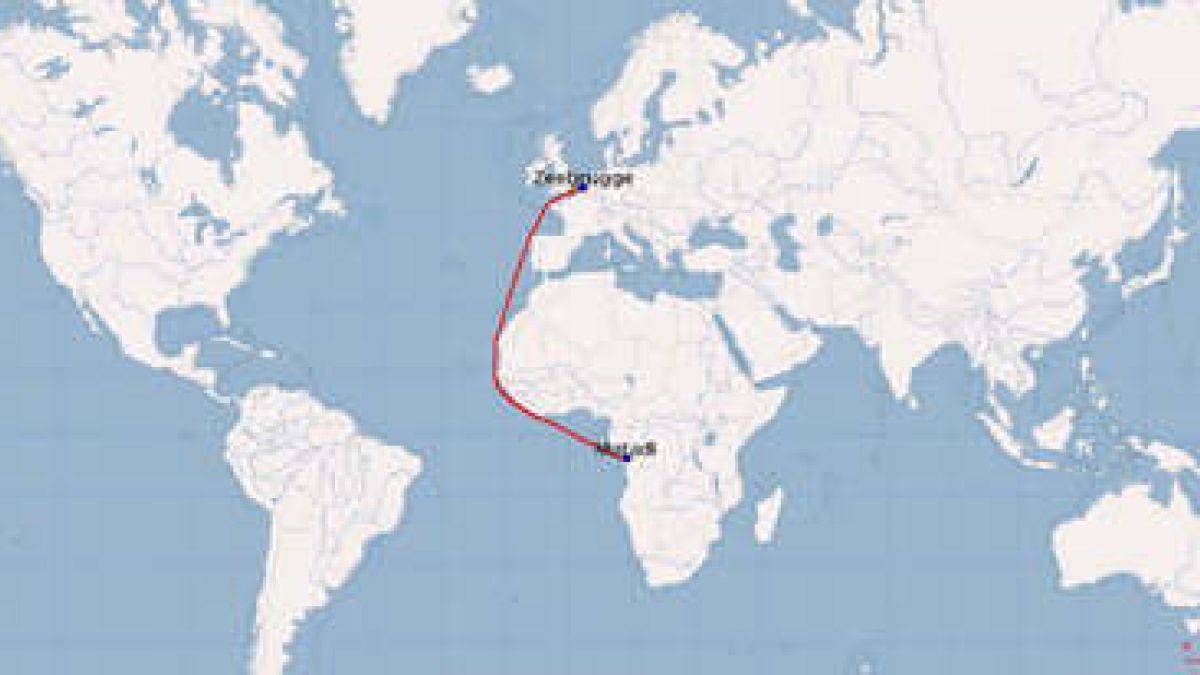
Arrival of the "Mama Mobokoli” at his berth
On 21st August, the Mama Mobokoli safely arrived at its final destination in Matadi, DRC. The journey took 39 days and was 4915 nautical miles long. This is 5.652,25 miles or 9.102,58 km. The Mama Mobokoli started its voyage on 12th July, when it left the harbour of Zeebrugge at 11h50.
The journey went from Zeebrugge, through the Gulf of Biskaye, across the North Atlantic ocean in front of Gibraltar in the direction of the Canary Islands, alongside the coastline of Western Africa (Senegal, Guinea Bissau, Guinea, Sierra Leone, Liberia, Ivory Coast), across the Gulf of Guinea (while crossing the Equator) to reach the Congo River Delta in the Democratic Republic of Congo, and the final destination of Matadi Port on the Congo River.
The tug and barge only had to stop twice during this lengthy voyage: once to shelter for bad weather, and once because of a damaged towing line. The surveyor at Zeebrugge stated that the convoy should look for shelter when the windspeed exceeded 5 Beaufort and waves were higher than 1,5 – 2,5 meters (“moderate seas”). On 24th and 25th July, with windspeed from 6 to 7 Beaufort and “rough sea”, Captain Janusz decided to take shelter along the South coast of Fuerteventura, the Canary Islands. On 18th August, at 05h30, a towing line broke. Half a day later it was repaired but the convoy had to drop anchor in the evening as it was not allowed to travel on the Congo river after darkness. This was very near the end point of the voyage (Matadi) at very close distance of Boma. Boma and Matadi are the two main ports on the Congo river, Matadi being the furthest inland.
On 19th August, the tug and barge made a stop along the Congo river at Boma, to empty the ballast tanks. For the crossing of the Atlantic the ballast tanks were filled with over 200 tons of ballast water to improve “barge wave response” times and as such improve the barge stability. But because there are some rapids between Boma and Matadi (Devil’s Kettle Rapids, where the speed of the river is around 6 knots this time of year), the ballast tanks were emptied, thus reducing the weight and towing resistance. Moreover, Captain Moszkowicz from Seaboard assisted Captain Janusz during the last nautical miles towards the Mama Mobokoli’s berth nr. 11 at Matadi Port.
E-Crane® is confident that the new floating transfer station “Mama Mobokoli”, together with other major investments in 6 new silos, will contribute to the continued success of the Midema flour mill and to the efficiency in unloading and loading ocean going vessels at Matadi!
[divider_arrow]
Pictures of the Mama Mobokoli with 1500B Series E-Crane® and tug Leopard leaving the port of Zeebrugge (assistance by URS harbour tug and after locks by URS ocean tug). Pictures by Geert Maenhout & Antoon Geirnaert.
The tug Leopard was build by the Flemish shipyard Beliard Murdoch in Ostend (Oostende) in the year 1969. The engine today is still the original engine made by Cockerill-Ougree also from Belgium. It goes without saying that this 1650 hp. motor has several times been rebuilt. For a long time the tug has been used in the harbor of Antwerp and Zeebrugge and tug was owned by URS who is the leading towing and assistance company in Zeebrugge and Antwerp. As a matter of fact, the tug was even recognized when leaving the port of Zeebrugge by the captain of the assisting URS tug ! For the towing of the the Mama Mobokoli the tug is equiped with a 60 (sixty) ton towing winch with 600 meter of 38 mm towing steel wire. The tug has also another 600 meter of spare cable on board. An emergency 220 meter long towing wire (rope) has been installed on board of the Mama Mobokoli. This rope is a self floating, polypropylene rope that can be reached and connected easely in case of a cable breakage. There is a riding crew of 6 on board (captain or master of the tug, the chief officer, the chief engineer, the cook and 2 helpers). The distance between the tug and the barge was between 200 and 400 meters.
The barge Mama Mobokoli was foreseen with big white painted rectangles on the bow section just above the waterline. This was required for the journey, to make sure the captain could easily verify the condition of the barge during the voyage.
Pictures of the Mama Mobokoli with 1500B Series E-Crane® and tug Leopard arriving in the Port of Matadi, at its berth nr. 11. Pictures by Jim Gutsch.















